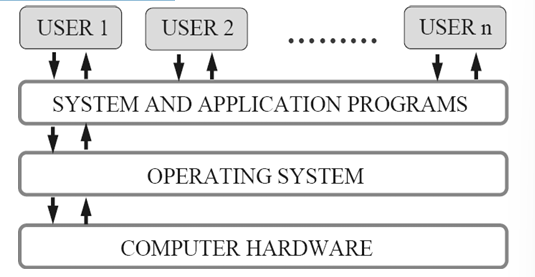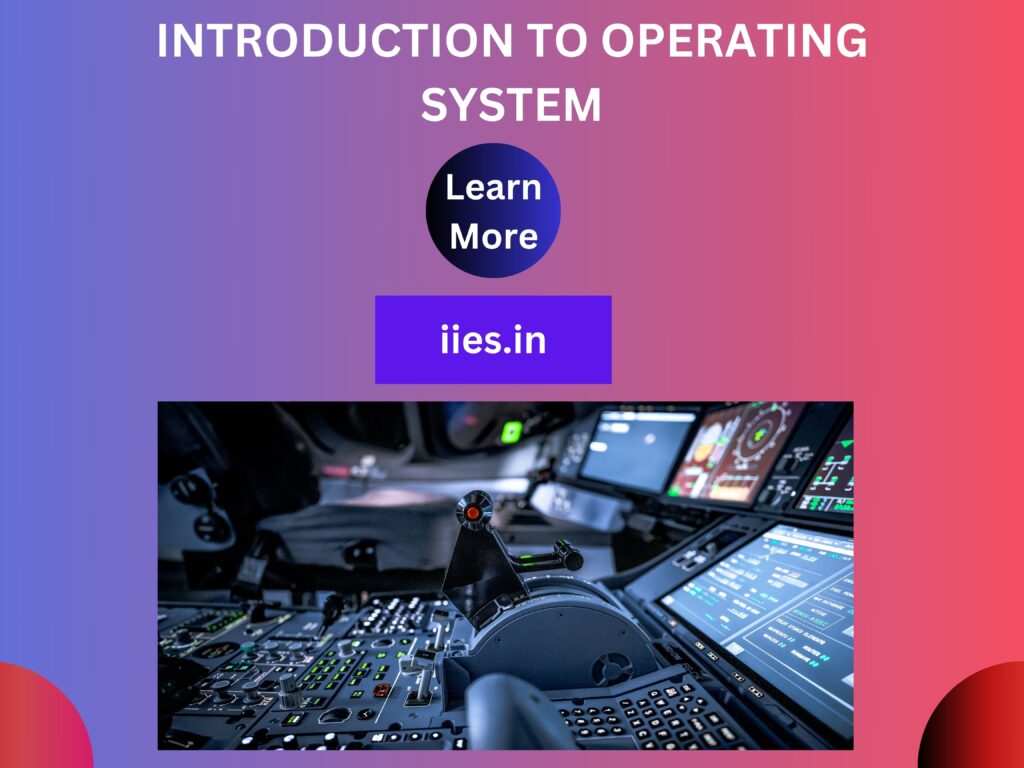What is an Operating System?
- A program that acts as an intermediary between a user of a computer and the computer hardware.
- An operating System is a collection of system programs that together control the operations of a computer system.
Some examples of operating systems are UNIX, Mach, MS-DOS, MS-Windows, Windows/NT, Chicago, OS/2, MacOS, VMS, MVS, and VM.
Operating system goals:
- Execute user programs and make solving user problems easier.
- Make the computer system convenient to use.
- Use the computer hardware in an efficient manner.
Computer System Components
- Hardware – provides basic computing resources (CPU, memory, I/O devices).
- Operating system – controls and coordinates the use of the hardware among the various application programs for the various users.
- Applications programs – Define the ways in which the system resources are used to solve the computing problems of the users (compilers, database systems, video games, business programs).
- Users (people, machines, other computers).
Abstract View of System Components.

Operating System Definitions
- Resource allocator – manages and allocates resources.
- Control program – controls the execution of user programs and operations of I/O devices .
- Kernel – The one program running at all times (all else being application programs).
- Components of OS: OS has two parts. (1)Kernel.(2)Shell.
- Kernel is an active part of an OS i.e., it is the part of OS running at all times. It is a programs which can interact with the hardware. Ex: Device driver, dll files, system files etc.
- Shell is called as the command interpreter. It is a set of programs used to interact with the application programs. It is responsible for execution of instructions given to OS (called commands).
Operating systems can be explored from two viewpoints: the user and the system.
User View: From the user’s point view, the OS is designed for one user to monopolize its resources, to maximize the work that the user is performing and for ease of use.
System View: From the computer’s point of view, an operating system is a control program that manages the execution of user programs to prevent errors and improper use of the computer. It is concerned with the operation and control of I/O devices.
Functions of Operating System:
Process Management
A process is a program in execution. A process needs certain resources, including CPU time, memory, files, and I/O devices, to accomplish its task.
The operating system is responsible for the following activities in connection with process management.
- Process creation and deletion.
- process suspension and resumption.
- Provision of mechanisms for:
- process synchronization
- process communication
Main-Memory Management
- Memory is a large array of words or bytes, each with its own address. It is a repository of quickly accessible data shared by the CPU and I/O devices.
- Main memory is a volatile storage device. It loses its contents in the case of system failure. The operating system is responsible for the following activities in connections with memory management:
- Keep track of which parts of memory are currently being used and by whom.
- Decide which processes to load when memory space becomes available.
- Allocate and de-allocate memory space as needed.
File Management:
- A file is a collection of related information defined by its creator. Commonly, files represent programs (both source and object forms) and data.
- The operating system is responsible for the following activities in connections with file management:
- File creation and deletion.
- Directory creation and deletion.
- Support of primitives for manipulating files and directories.
- Mapping files onto secondary storage.
- File backup on stable (nonvolatile) storage media.
I/O System Management
- I/O system consists of:
- A buffer-caching system
- A general device-driver interface
- Drivers for specific hardware devices
Secondary-Storage Management
Since main memory (primary storage) is volatile and too small to accommodate all data and programs permanently, the computer system must provide secondary storage to back up main memory. Most modern computer systems use disks as the principle on-line storage medium, for both programs and data. The operating system is responsible for the following activities in connection with disk management:
- Free space management
- Storage allocation
- Disk scheduling
Networking (Distributed Systems)
- A distributed system is a collection processors that do not share memory or a clock. Each processor has its own local memory.
- The processors in the system are connected through a communication network.
- Communication takes place using a protocol.
- A distributed system provides user access to various system resources.
- Access to a shared resource allows:
- Computation speed-up
- Increased data availability
- Enhanced reliability

